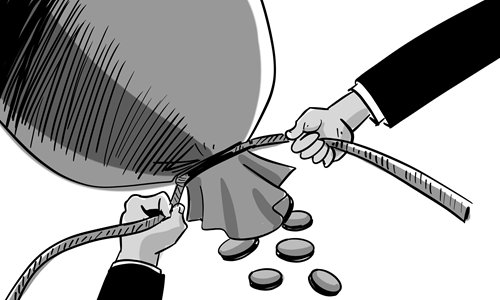HOME >> BUSINESS
Is there room for future monetary easing in China amid global economic uncertainty?
By Lian Ping Source:Global Times Published: 2019/8/6 18:38:42

Illustration: Luo Xuan/GT
Amid increasing external uncertainty, slowing global economic growth, the Fed's interest rate cut and continuing downward pressure on the Chinese economy, the market is looking to see China further ease its monetary policy. How much room is there for monetary easing in China?
Since this year, the rhetoric from monetary authorities on policy has been split. One path is to continue counter-cyclical adjustments, while the other is to implement counter-cyclical adjustments in a timely and appropriate manner. It is not hard to discern that the latter course indicates authorities are somewhat reserved on counter-cyclical adjustments. The change in official tone signifies that although there is room for monetary policy easing, it is subject to a series of factors.
Since the start of 2018, China's central bank has enacted five overall and structural cuts to reserve requirement ratio (RRR), reducing the average bank deposit reserve ratio to 11 percent, about 3 percentage points lower than the 2017 average. Meanwhile, the central bank has used various open market tools to increase short- and medium-term liquidity and drive down interest rates. As a result, market liquidity has been maintained sufficiently, and even quite abundantly at certain stages.
By the end of 2018, supplies of narrow money (M1) and broad money (M2) grew 1.5 percent and 8.1 percent year-on-year, respectively. By the end of June this year, the growth rates for M1 and M2 rebounded to 4.4 percent and 8.5 percent.
Considering that the growth in nominal GDP has slid to 8.3 percent, the growth rate of M2 is basically matching nominal GDP. Moreover, the monetary multiplier has recorded a big change, climbing from a low of 5.41 during the second half of 2018 to 6.14 in June 2019, a historical high. Apparently, it is inappropriate to further loosen monetary policy under such a liquidity situation. Interest rates have continued to fall the domestic market since the second quarter of 2019. The current level of real interest rates is much lower than the level a decade ago. In principle, China's interest rates should be higher than in the US, because the existence of a reasonable interest spread is favorable to maintaining net capital inflows. In this sense, even though the Fed announced an interest rate cut, the space is still limited for interest rate cuts in China.
Except for the relatively stable leverage ratio at the corporate sector, leverage levels of the government and residents have increased since 2018. From the beginning of 2018 to the first quarter of 2019, leverage ratios of the government and residents went up from 35.77 percent and 50.38 percent to 37.67 percent and 54.28 percent, respectively, while the corporate sector only saw leverage ratios decline from 158.9 percent to 156.88 percent. So the overall leverage level increased by about 3.8 percentage points during the same period.
In my opinion, it seems an exaggeration to worry too much about current leverage and debt levels. Some economies, with even higher leverage levels than China, still maintain economic stability for a long time. Nevertheless, the fact that China's macro leverage ratio is indeed relatively high will unlikely cause any fundamental change to its leverage stabilizing policy in the near future, unless the economy comes under major shocks or faces an obvious stall. With the leverage ratio climbing, a further loosening of monetary policy may risk lifting the leverage ratio significantly, which goes against deleveraging or stabilizing leverage policies.
With weakening internal and external demand, the economy faces downward pressure, and with the current account surplus declining, depreciation may still be the main risk to the yuan exchange rate in the future. As monetary policy is an important factor, sometimes even a decisive factor, affecting the exchange rate movement, a loose monetary policy will inevitably put depreciation pressure on the yuan. Thus, for the sake of keeping the yuan exchange rate basically stable and reducing depreciation pressure, authorities are not advised to further loosen the monetary policy easily.
All in all, China's nominal interest rate and real interest rate are currently both at low levels from the perspective of history and the world market. So further cutting interest rates sharply may only produce a limited effect, and such a move is subject to multiple factors.
Meanwhile, the current required RRRs at banks have generally reached an average of 11 percent after several downward adjustments, which is already quite low in the international market, representing limited room for any further slash.
Nevertheless, it is still possible to loosen monetary policy appropriately if the macro economy suffers any major setback in the future. With the advance of interest rate marketization, the use of price-based tools will gradually become the main approach for adjusting monetary policy.
The author is chief economist with Bank of Communications. bizopinion@globaltimes.com.cn
Posted in: EXPERT ASSESSMENT